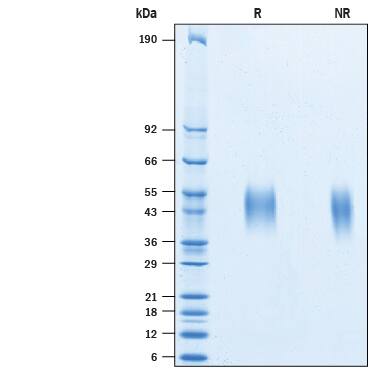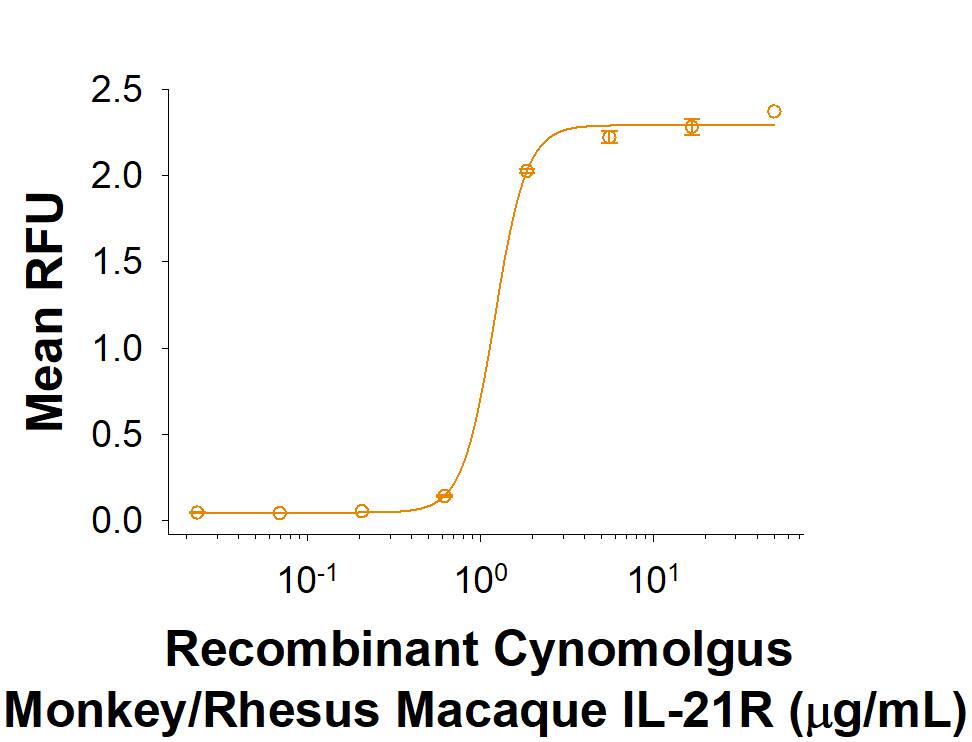Recombinant Cynomolgus/Rhesus Macaque IL-21R His Protein, CF
R&D Systems, part of Bio-Techne | Catalog # 10837-R2

Key Product Details
- R&D Systems CHO-derived Recombinant Cynomolgus/Rhesus Macaque IL-21R His Protein (10837-R2)
- Quality control testing to verify active proteins with lot specific assays by in-house scientists
- All R&D Systems proteins are covered with a 100% guarantee
Product Specifications
Source
Cys20-Pro236, with a C-terminal 6-His tag
Purity
Endotoxin Level
N-terminal Sequence Analysis
Predicted Molecular Mass
SDS-PAGE
Activity
When Recombinant Human IL-21 Proteinis (Catalog # 8879-IL) immobilized at 2.50 μg/mL, 100 μL/well, the concentration of Recombinant Cynomolgus Monkey/Rhesus Macaque IL-21R His-tag (Catalog# 10837-R2) that produces 50% of the optimal binding response is approximately 0.40-2.40 μg/mL.
Scientific Data Images for Recombinant Cynomolgus/Rhesus Macaque IL-21R His Protein, CF
Recombinant Cynomolgus Monkey/Rhesus Macaque IL-21R His-tag Protein Binding Activity.
When Recombinant Human IL-21 Protein is (8879-IL) immobilized at 2.50 μg/mL, 100 μL/well, the concentration of Recombinant Cynomolgus Monkey/Rhesus Macaque IL-21R His-tag (Catalog# 10837-R2) that produces 50% of the optimal binding response is approximately 0.40-2.40 μg/mLRecombinant Cynomolgus Monkey/Rhesus Macaque IL-21R His-tag Protein SDS-PAGE.
2 μg/lane of Recombinant Cynomolgus Monkey/Rhesus Macaque IL-21R His-tag (Catalog # 10837-R2) was resolved with SDS-PAGE under reducing (R) and non-reducing (NR) conditions and visualized by Coomassie® Blue staining, showing bands at 40-55 kDa.Formulation, Preparation and Storage
10837-R2
| Formulation | Lyophilized from a 0.2 μm filtered solution in PBS. |
| Reconstitution | Reconstitute at 500 μg/mL in PBS. |
| Shipping | The product is shipped at ambient temperature. Upon receipt, store it immediately at the temperature recommended below. |
| Stability & Storage | Use a manual defrost freezer and avoid repeated freeze-thaw cycles.
|
Background: IL-21R
Interleukin-21 Receptor (IL-21 R) is a type I transmembrane glycoprotein within the class I cytokine receptor family (1). IL-21 R associates with the common gamma chain (gamma c) which is also a component of the receptors for IL-2, IL-4, IL-7, IL-9, IL-13, and IL-15 (2, 3). Mature cynomolgus/rhesus IL-21 R is consists of an extracellular domain (ECD), a fibronectin type III domain, and a WSxWS motif, followed by a transmembrane domain and a cytoplasmic domain with a Box 1 motif, a kinase domain, and several sites for tyrosine phosphorylation (4, 5). Within the ECD, cynomolgus/rhesus IL-21 R shares 98% amino acid identity with human IL-21 R. IL-21 R is expressed mainly on B cells (highest on mature, activated, follicular and germinal center B cells), NK cells, and activated T cells, but is also found on dendritic cells, alternatively activated macrophages, intestinal lamina propria fibroblasts and epithelial cells, and keratinocytes (1, 4, 5). Both IL-21 and IL-4 are necessary for efficient B cell IgG1 production and normal germinal center architecture (6). B cell IL-21 R engagement induces Blimp-1 (which mediates plasma cell differentiation) and is important for memory responses (7, 8). IL-21 R engagement enhances NK cell mediated cytotoxic activity and IFN-gamma production (4, 9), control of viral infection and tumor growth by CD8+ T cells (10), development of regulatory T cells (11), IL-23 responsiveness of encephalitogenic Th17 cells (12), but suppresses the accumulation of IL-17 secreting gamma delta T cells in the airway (13). IL-21 R expression is often upregulated in allergic skin inflammation, systemic lupus erythematosus and diffuse large B cell lymphoma (DLBCL) (14, 15).
References
- Tangye, S.G. (2015) Curr. Opin. Immunol. 34:107.
- Asao, H. et al. (2001) J. Immunol. 167:1.
- Habib, T. et al. (2002) Biochemistry 41:8725.
- Parrish-Novak, et al. (2000) Nature 408:57.
- Ozaki, K. et al. (2000) Proc. Natl. Acad. Sci. USA 97:11439.
- Ozaki, K. et al. (2002) Science 298:1630.
- Rankin, A.L. et al. (2011) J. Immunol. 186:667.
- King, I.L. et al. (2010) J. Immunol. 185:6138.
- Kasaian, M.T. et al. (2002) Immunity 16:559.
- Frohlich, A. et al. (2009 Science 324:1576.
- Tortola, L. et al. (2010) Blood 116:5200.
- Lee, Y. et al. (2015) J. Clin. Invest. 125:4011.
- Moser, E.K. et al. (2015) PLoS One 10:e0120169.
- Jin, H. et al. (2009) J. Clin. Invest. 119:47.
- Sarosiek, K.A. et al. (2010) Blood 115:570.
Long Name
Alternate Names
Entrez Gene IDs
Gene Symbol
UniProt
Additional IL-21R Products
Product Documents for Recombinant Cynomolgus/Rhesus Macaque IL-21R His Protein, CF
Product Specific Notices for Recombinant Cynomolgus/Rhesus Macaque IL-21R His Protein, CF
For research use only

